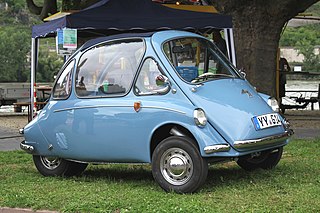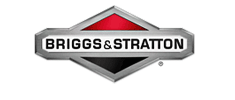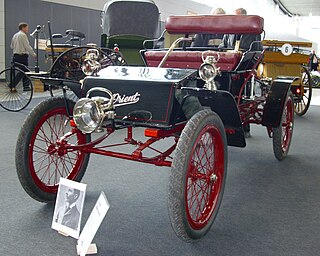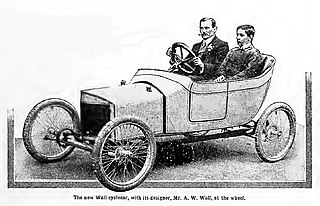
Jowett was a manufacturer of light cars and light commercial vehicles in Bradford, West Riding of Yorkshire, England from 1906 to 1954.

Microcar is a term often used for the smallest size of cars, with three or four wheels and often an engine smaller than 700 cc (43 cu in). Specific types of microcars include bubble cars, cycle cars, invacar, quadricycles and voiturettes. Microcars are often covered by separate regulations to normal cars, having relaxed requirements for registration and licensing.

A cyclecar was a type of small, lightweight and inexpensive motorized car manufactured in Europe and the United States between 1910 and the early 1920s. The purpose of cyclecars was to fill a gap in the market between the motorcycle and the car. It could accommodate only two passengers, often sitting in tandem.

Briggs & Stratton Corporation is an American manufacturer of small engines with headquarters in Wauwatosa, Wisconsin.

Singer Motors Limited was a British motor vehicle manufacturing business, originally a bicycle manufacturer founded as Singer & Co by George Singer, in 1874 in Coventry, England. Singer & Co's bicycle manufacture continued. From 1901 George Singer's Singer Motor Co made cars and commercial vehicles.

Motobécane was a French manufacturer of bicycles, mopeds, motorcycles, and other small vehicles, established in 1923. "Motobécane" is a compound of "moto", short for motorcycle; "bécane" is slang for "bike."

Waltham Manufacturing Company (WMC) was a manufacturer of bicycles, motorcycles, motorized tricycles and quadricycles, buckboards, and automobiles in Waltham, Massachusetts. It sold products under the brand names Orient, Waltham, and Waltham-Orient. The company was founded in 1893, moving to self-propelled vehicles after 1898.

The King Midget was a micro car produced between 1946 and 1970 by the Midget Motors Corporation. The King Midget company started out by offering a kit to build a car, but soon added completely assembled cars and later only offered completed cars.

A motorized bicycle is a bicycle with an attached motor or engine and transmission used either to power the vehicle unassisted, or to assist with pedalling. Since it sometimes retains both pedals and a discrete connected drive for rider-powered propulsion, the motorized bicycle is in technical terms a true bicycle, albeit a power-assisted one. Typically they are incapable of speeds above 52 km/h (32 mph); however, in recent years larger motors have been built, allowing bikes to reach speeds of upwards of 113 km/h.

Murray was an American company whose assets are now owned by Briggs & Stratton and Pon Holdings. The corporate brand is a descendant of the Murray Ohio Manufacturing Company, which manufactured bicycles and lawn and garden equipment. The company went bankrupt in 2005 selling most of its assets to Briggs & Stratton and Pacific Cycle.

MTD Products is an American manufacturer of outdoor power equipment for the mass market. Headquartered in Valley City, Ohio, the company began in 1932 and is a wholly-owned subsidiary of Stanley Black & Decker. Prior to Stanley Black & Decker's acquisition in December 2021, MTD Products was a majority family-owned, private company. It originated as a tool and die maker. MTD's main competitors are Stihl, Ariens, Briggs & Stratton, John Deere and Husqvarna.
Eshelman was a marque of small American automobiles (1953–1961) and other vehicles and implements including motor scooters, garden tractors, pleasure boats, aircraft, golf carts, snowplows, trailers, mail-delivery vehicles and more. The Cheston L. Eshelman Company was incorporated on January 19, 1942, and was based on the sixth floor of an industrial building at 109 Light Street in Baltimore, Maryland, with aircraft production facilities located in Dundalk, Maryland. The company president was Cheston Lee Eshelman, the first vice-president was Sidney S. Zell, and the first treasurer was Frank K. Kris.

The New Hudson Cycle Co. was originally started in 1890 by George Patterson, and manufactured 'safety' bicycles in Birmingham. In 1903 they produced their first motorcycle, but times became tough for Patterson after one of his sons died in WW1 and the other lost a leg. The family sold the factory to HJ Bructon after WW1, and in 1920 the company was reformed as New Hudson Ltd.

Douglas was a British motorcycle manufacturer from 1907 to 1957 based in Kingswood, Bristol, owned by the Douglas family, and especially known for its horizontally opposed twin cylinder engined bikes and as manufacturers of speedway machines. The company also built a range of cars between 1913 and 1922.

The Smith Flyer was an American automobile manufactured by the A.O. Smith Company in Milwaukee from 1915 until about 1919 when the manufacturing rights were sold to Briggs & Stratton and it was renamed the Briggs & Stratton Flyer.

The Red Bug, later marketed as the Auto Red Bug were a vintage era cyclecar automobile manufactured by the Automotive Electric Service Corp. of North Bergen, New Jersey from 1924 to 1930. It is considered an early version of a microcar.

Victa is an Australian manufacturer of outdoor garden equipment, including petrol, electric, and battery-powered lawn mowers, edgers, trimmers, and chainsaws. The brand is best known as a manufacturer of rotary lawn mowers. In the early 1960s the company also built light aircraft, notably the Victa Airtourer, and project homes.
Cycle-Scoot is an American line of scooters created by aircraft engineer & entrepreneur Woodrow Wilson Skirvin in 1953. The scooter was largely popular during the 1950s due to its Indianapolis "500" campaign & wide distribution across the country.

Arthur William Wall was an engineer in the field of motorised transport and inventor of the self-powered wheel in England in the early 20th century. He is best known for his creation of the self-powered wheel, the Wall Autowheel, which could be used to power a bicycle, but he was also the man behind Roc motorcycles and a tricar and four-wheel cyclecar. His main company was A. W. Wall Ltd, but he created several other companies to compartmentalise his different activities, such as the Roc Gear Co, who supplied epicyclic gears to a significant number of manufacturers before WW1.


















